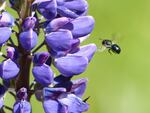
Wild bees are more abundant than cultivated bees. That's one reason they are considered important pollinators.
Jim Rivers, College of Forestry / OSU
An Oregon land use commission moved last May
to restrict commercial solar development
on prime farmland in the state. The rule takes millions of acres with some of the highest potential for solar energy production off the table.
But research from Oregon State University is showing that agriculture and solar development don’t have to be at odds from a production standpoint.
In fact, solar arrays can work in tandem with and sometimes boost systems that are beneficial for agricultural.
OSU master’s degree student Maggie Graham has been studying the effectiveness of purposefully planting pollinator habitat in and around solar arrays.
“Pollinator habitat is in decline in the state and nationwide as a result of land use change,” Graham said.
“So in communities that are wanting to install renewable energy and promote pollinating insects [this kind of system] would be a possibility.”
Related: Oregon Restricts Solar Development On Prime Farmland
It’s relatively rare that commercial solar arrays take advantage of the land around and between panels. Graham said developers will sometimes pave the ground or put down gravel.
Graham looked at the effectiveness of planting a mix of native plants that attract pollinators – like bees and butterflies – around a commercial solar array near Medford. Most agriculture relies on pollinators in some way for production. She counted the number of flower blooms and insects in areas under the solar panels, between the solar panels and in areas to the side of the array.
What she saw in her preliminary data collected last summer suggests the solar array did not detract from pollinator use.
“We found that in both flowers and bees, there were more of them in the aisles between the panels than outside,” she said.
The findings suggest that the plants were actually more robust in the areas between the panels than the areas where there were no solar structures at all. More robust plants attracted more beneficial insects.
Graham says, based on previous research at Oregon State, shade could be the difference. One study looked at how livestock pasture forage grew around solar arrays.
“We found that biomass [the amount of plant material] increased and soil moisture increased under the array. In a water limited environment, that allowed these plants to grow better,” she said.
Chad Higgins, an OSU agriculture professor, says in most of Oregon, farm land had plenty of sun – it’s water that’s the limiting factor in determining where to grow crops. He sees a broader opportunity to specifically design solar arrays on farmland to provide shade and decrease the amount of water needed to grow crops.
“The general idea is to start thinking about light as a farm resource, just as you would think of the soil or the fertilizer of the plants or the water. Why not harvest and manipulate that light for maximum agronomic benefit?” Higgins asked.
Over the next few months Graham will be analyzing her data to determine the diversity of plants and insects that were using the solar array. The answers she finds will begin to answer questions about the opportunities available to make maximum use of the solar arrays already in place.
“If we've got unused land," she says, "why not put habitat for pollinators there?”
